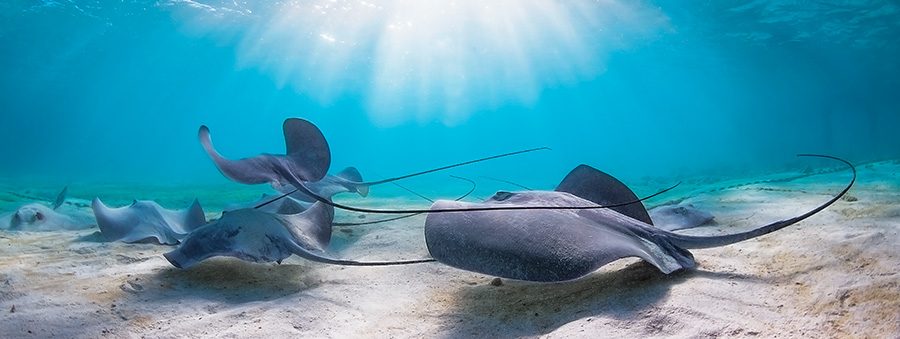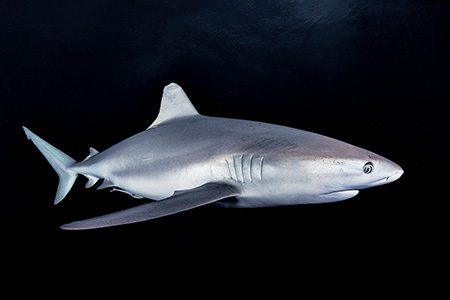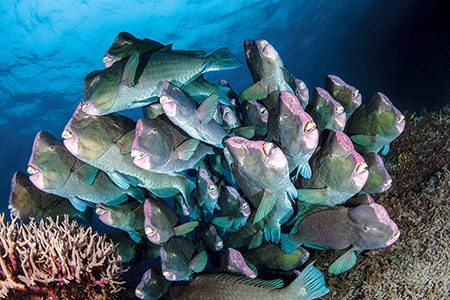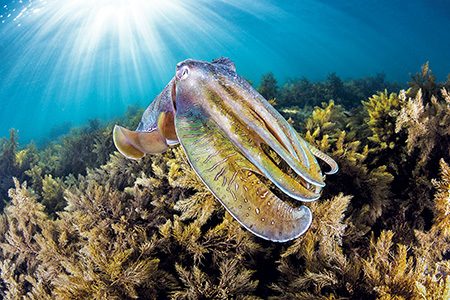Imagine waking up in the early hours of the morning at your favorite dive site. The sun hasn’t quite peaked above the horizon, and light is minimal. You don your dive gear, grab your camera, and giant stride off the back of the boat to begin your descent into the dimly lit ocean.
Shortly after beginning your dive, you look up and notice a flash of golden light flickering beneath the surface of the water. As time goes on, this light becomes more pronounced until eventually it splits and radiates down through the ocean in the most spectacular fashion. For the next one to two hours, you’re in photography heaven as you fill your memory card shooting a variety of subjects with a range of captivating compositions. Welcome to shoulder light.
Shoulder light spans the few hours around sunrise and sunset. Forcing yourself out of bed during the early hours of the morning or squeezing into a wet wetsuit at the end of the day is not everyone’s idea of a good time, but if you’re an underwater photographer with a desire to capture those extra special images, then it’s worth the effort.
In addition to the dazzling display of golden light, you may also witness a variety of species and animal behaviors not typically seen during normal daylight hours. As a photographer who focuses on larger animals, I have taken advantage of shoulder light as a key component in developing my portfolio.

Optimize Timing
For early morning optimization, start your dive at least half an hour prior to sunrise and stay up to two hours afterward, boat schedules permitting. The light’s intensity will gradually increase during the 30 to 60 minutes after sunrise, but don’t abort the dive too early because conditions can remain excellent for some time afterward.
For late afternoon shooting, enter the water up to an hour before sunset. The best lighting typically occurs in those final 60 minutes before the sun drops below the horizon. This will give you ample time to get settled on your dive, scope out some nice scenery for compelling backgrounds, and find relaxed and willing subjects. There are few things worse than having incredible light rays piercing down from above but having nothing to shoot.
These hours are a fantastic time to be in the water to not only experience a wide variety of species but also witness a range of different behaviors, such as sea turtles feeding on a coral reef, stingrays foraging along the seafloor, or sharks preparing to hunt. On the Great Barrier Reef in Australia, I was lucky to find a large school of bumphead parrotfish packed closely together in an attempt to ward off predators during the night — a unique behavior likely to be observed only during the early hours of the morning or late afternoon. Regardless of where you are diving, you will discover that dusk and dawn are rewarding times to experience our underwater treasures.
Stay Shallow
Like all forms of light, sunrays dissipate quickly upon hitting the surface of the water, but more so in the early morning and late afternoon as the tangential light rays bounce off the surface more than they penetrate it. Even at depths as shallow as 33 feet (10 meters), light can fade dramatically. If your goal is to feature the light in a way that really stands out, it’s best to remain within the top 20 feet (6 meters).
If scuba diving, be sure to watch your buoyancy — it can be easy to inadvertently ascend near the surface when working at such shallow depths. Leaving the tanks behind and instead opting for only a mask, snorkel, and fins can be a more simplistic way to capture the light.
Maximize Light with Angles
It’s important to be aware of your shooting angle when framing subjects. Even small adjustments can enhance or diminish the appearance of sunlight. When composing images, be sure to keep one eye on the viewfinder or rear LCD display while experimenting with different angles until you have it right.
Tilting your camera housing slightly upward to better capture the sun within your composition yields great results, but there really is no right answer. The keys are to compose with purpose and develop a habit of paying particular attention to the way the light is behaving relative to your subject.
Shoot Wide
As a lifelong Nikon shooter, I almost exclusively work with an 8-15mm fisheye. These wide-angle lenses are particularly well adapted for capturing shoulder light. The super-wide field of view allows for striking compositions including just about all the available sunrays beaming down from above.
Such lenses are also known for their close focusing abilities, making them well suited for intimate encounters, improved exposure, image sharpness and overall quality. If you don’t have access to a lens with a similar focal length, simply go as wide as you can. The idea is to be greedy: Compose with as much early morning or late afternoon light as possible.
Strobe Lighting
As amazing as the photo opportunities can be during early morning and late afternoon, shooting at such times presents some challenges. One of the most difficult obstacles is the lack of natural light, which you can overcome by using strobe lighting. Strobes not only add a source of exposure but also unlock the ability to shoot directly toward the sunlight without any silhouetting or heavy shadowing occurring on your subject.
With strobe power, the goal is to provide a sufficient burst of light to overcome the sun’s backlighting while being mindful not to overexpose your subject. While it may sound counterintuitive, starting with your strobes set to low power and making only small incremental increases as required is the best way to ensure a nice exposure. The best images are typically those captured at very close range to your subject, and a low-powered burst of light is usually all that’s required.
Camera Settings
Another method for combatting the low natural light conditions associated with shoulder light is balancing shutter speed, aperture, and ISO. The answer to the age-old question, “What camera settings should I use?” will always depend on the specific conditions available at the time, but there are a few helpful principles to keep in mind.
When light is at its dimmest, be prepared to work with slow shutter speeds to maintain a balanced exposure. While shooting with strobes, you can use shutter speeds of 1/160 to 1/125 and even slower in extreme cases to allow more light to reach your camera’s sensor for a pleasing exposure.
An aperture of f/8 is a great starting point underwater, and a low ISO ensures image quality and prevents blowing out the scene with excessive brightness. Exposure is always a combination of ISO, shutter speed, and aperture as variables for the ambient light background, while strobe power and strobe-to-subject distance influence the foregrounds.
Whether the sun is continuing to rise or set when you’re in the water, the amount of available light will be changing quickly, and you will need to frequently adjust your settings. As light begins to reach peak intensity, look to increase your shutter speed in line with your maximum strobe sync speed (1/200 to 1/250 for most cameras) to better freeze light rays for spectacular sunburst-styled images.
Above and Below
As impressive as the underwater world is, save some time for split photography. Whether it be sunrise or sunset, this is the best time to capture over-under images as the sky offers up wondrous warm hues. While the difficulty factor can be high, few images elicit the same degree of awe as a well-composed split shot captured during shoulder light.
Rush Hour
As luck would have it, the time when shoulder light is at its best coincides with one of the busier times at a dive site, particularly on a coral reef. If photographing the golden light isn’t enough reward for you to commit to those early morning or late afternoon dives, the promise of a greater variety of marine life surely will be.
Depending on whether you’re diving at sunrise or sunset, you will have a great chance of experiencing both daytime and nocturnal species. Early mornings in particular offer fantastic photo opportunities with many animals emerging from their shelters for the first time. Diving at such times makes it easier to find unique, more active, and just plain interesting subjects. Always remember not only to look up and around but also to explore nooks and crannies — you never know what you might find.
The next time you’re on a dive trip and contemplating whether it’s worth making the early start or taking on that final dive of the day, just get in the water. There really is no better time to go diving. The combination of spectacular lighting opportunities along with a variety of unique and interesting behaviors makes for truly special underwater photography.




© Alert Diver — Q1 2024